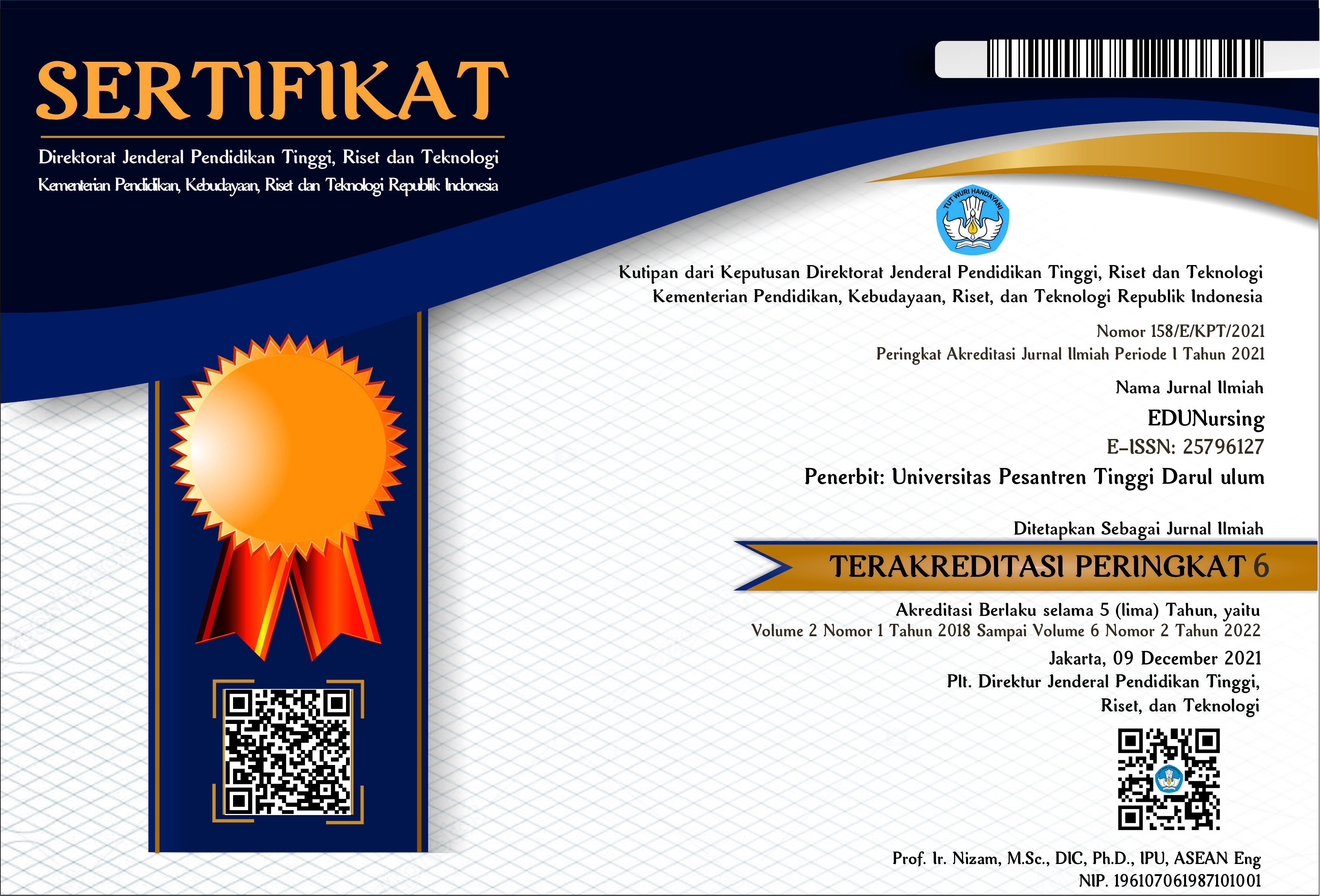ANALISIS PENILAIAN TRIAGE DAN REVISED TRAUMA SCORE DALAM MEMPREDIKSI MORTALITAS PADA PASIEN TRAUMA KEPALA
Abstract
ABSTRACT
Improper handling of management systems and quickly increase mortality in head injuries. Triage assessment can reduce the risk of death. However, triage is at risk of undertriage which can increase mortality. A more detailed assessment system is needed, so Revised trauma score (RTS) can be used to minimize undertriage. The purpose of this study is to analyze the triage assessment and RTS assessment in predicting mortality in cases of head trauma. The study design was observational analytic with cross sectional approach. The population was all head trauma patients in the emergency room at Jombang Regional Hospital with 121 patients. The sample consisted of 89 respondents taken using Simple Random Sampling. The research instrument used observation sheets. Data were analyzed using Chi-square test with a significance level of p <? (? = 0.05). The results of the triage and mortality assessment show a significance value of p = 0.00 (p <?), meaning that there is a relationship between the triage assessment and mortality. While the RTS assessment shows a significance value of p = 0.00 (p <?) so that, it means that there is a relationship between RTS assessment and mortality. Triage assessment can speed up the handling of head trauma and RTS can know the physiological status so as to determine an accurate action. Both triage assessment and RTS can predict mortality risk in head injuries.
Keywords: Head trauma, triage, Revised Trauma Score (RTS), mortalitas.
References
DAFTAR PUSTAKA
Aprilia, H. (2017). Gambaran Status Fisiologis Pasien Cedera Kepala Di IGDR SUD Ulin Banjarmasin Tahun 2016. Dinamika Kesehatan. Vol. 8, No. 1
Awaloei, A.C., Nola T.S.M., & Djemi T. (2016). Gambaran Cedera Kepala Yang Menyebabkan Kematian di Bagian Forensik dan Medikolegal RSUP Prof Dr. R. D. Kandou periode Juni 2015-Juli 2016. Jurnal e-Clinic (eCl). Vol. 4, No. 2
Azizah, L. (2011). Keperawatan Lanjut Usia. (Edisi Pertama). Jakarta: Graha Ilmu.
Brazinova, A., Mauritz W., Leitgeb J., Wilbacher I., Janciak, I. (2010). Outcome of Patients With Severe Traumatic Brain Injury Who Have Glasglow Coma Scale Scores of 3 or 4 and Are Over 65 years Old. Neurotrauma. Vol. 27 No. 9 (Hlm : 1549-55)
.
Celcilia, E., Virgiandhy, & Heru F.T. (2015). Gambaran Skor Trauma Pada Pasien Di UGD RSUD Dr.Soedarso Pontianak Menggunakan Revised Trauma Score (RTS) Periode Tahun 2012. Jurnal Artikel. Vol. 3, No. 1 (Hlm: 3).
Febrina, Wiwit & Indah Okzana Sholehat. (2018). Experience Of Nurse Assosiate To Implement Triage In Emergency Room Installation. Jurnal Endurance. Vol. 3, No. 1 (Hlm: 138-145)
Fikriana, Riza dan Al Afik. (2015). Korelasi Penilaian Revised Trauma Score (RTS) dengan Mortalitas Pasien Trauma di Instalasi Gawat Darurat RS PKU Muhammadiyah Yogyakarta. Jurnal Sain Med, Vol. 7., No. 96
Fitriana, N.F. (2018). Relationship Between Injury Mechanism And Other Trauma Of Organs With Prognosis Of Heavy Head Injuries In RSUD Margono Soekarjo Purwokerto. Jurnal Penelitian Keperawatan Vol. 4, No. 2.
Gustia, Mila & Melva Manurung. (2018). Hubungan Ketepatan Penilaian Triage Dengan Tingkat Keberhasialan Penanganan Pasien Cidera Kepala Di IGD RSU HKBP Balige Kabupaten Toba Samosir. Jurnal Ilmiah Penelitian Kesehatan. Vol. 3, No. 2 (Hlm: 100).
Haryatun, N & Sudaryanto A. (2008). Perbedaaan Waktu Tanggap Tindakan Keperawatan Pasien Cedera Kepala Kategori I-V di IGD RSUD Dr. Moewardi. Berita ilmu keperawatan ISSN. Vol. 1, No. 2 (Hlm. 1979-2697).
Irawan, Hendry, Felicia S., Dewi, & Georgius D. (2010). Perbandingan Glasgow Coma Scale dan Revised Trauma Score dalam Memprediksi Disabilitas Pasien Trauma Kepala di Rumah Sakit Atma Jaya. Maj Kedokt Indon. Vol. 60, No. 01
Kemenkes RI. (2013). Riset Kesehatan Dasar. Jakarta: Kementerian Kesehatan Republik Indonesia
Keputusan Menteri Kesehatan Republik Indonesia. (2009). Standar Instalasi Gawat Darurat (IGD) Rumah Sakit. Jakarta: Menteri Kesehatan Republik Indonesia.
Khairina, I., Ilfa K., Hema M., & Emil H. (2018). Faktor-Faktor Yang Berhubungan Dengan Pengambilan Keputusan Perawat Dalam Ketepatan Triase Di Kota Padang. Indonesian Journal for Health Sciences. Vol. 2, No. 1 (Hlm: 1-6).
Martini, M., Moch. H., & Dewi K. (2016). Perbedaan Survival Pasien Rujukan Dan Non Rujukan Dengan Cedera Kepala Di Instalasi Gawat Darurat (IGD) RSUD Dr. Saiful Anwar Malang. Jurnal Ilmu Keperawatan. Vol. 4, No. 2
Menteri Kesehatan Republik Indonesia. (2018). Peraturan Menteri Kesehatan Republik Indonesia Nomor 47 Tahun 2018 Tentang Pelayanan Kegawatdaruratan
Musliha. (2010). Keperawatan Gawat Darurat. Yogyakarta: Nuha Medika
Putri, Dianingrum, & Cemy Nur Fitria. (2018). Ketepatandan Kecepatan Terhadap Life Saving Pasien Trauma Kepala. Proceeding of The 7th University Research Colloquium 2018: Bidang MIPA dan Kesehatan. STIKES PKU Muhammadiyah, Surakarta.
Rembet, M.A., Reginus M., & T. Malara. (2015). Hubungan Response Time Perawat Dengan Tingkat Kepercayaan Keluarga Pasien Pada Triase Kuning (Urgent) Di Instalasi Gawat Darurat Rsu Gmim Kalooran Amurang. e-Journal Keperawatan (eKp). Vol. 3, No. 2
Ristanto R., Indra M.R., Poeranto S., & Setyorini I. (2016). Akurasi Revised Trauma Score Sebagai Prediktor Mortality Pasien Cedera Kepala, Jurnal Kesehatan Hesti Wira Sakti. Vol. 4, No. 2 (Hlm: 76-90).
Ristanto, Riski dkk. (2017). Comparative Analysis Of Accuracy Among Glasgow Coma Scale, Trauma Score, And Revised trauma score As Predictors Of Mortality Head Injury Patients. Jurnal Ilmu Keperawatan. Vol. 5, No. 2
Salim, Caroline. (2015). Sistem Penilaian Trauma. Kalbe Medicon. Vol. 42, No. 9 (Hlm: 702).
Shahraki, B.N., Mahmood Y., Mohammad J.H., Parviz K., Masoud B., Jalaledin M.R, Mehdi Y., Kavous S., Fatemah M. & Mostafa H. (2017). Worthing Physiological Score vs Revised Trauma Score in Outcome Prediction of Trauma patients; a Comparative Study. Emergency. Vol. 5, No. 1 (Hlm: 31).
Tude, M.J.R.., Rocco F.D.., Blanot S., Oliveira F.JA., Meyer P., & Zerah M. (2010). Neuro Surgery: Mortality In Children With Severe Head Trauma: Predictive Factors And Proposal For A New Predictive Scale. Vol. 67, No. 06 (Hal: 1542-1547).Ulya, I., Bintari R.K., Dewi K.N., & Respati S.D. (2017). Buku Ajar Keperawatan Gawat Darurat pada Kasus Trauma. Jakarta : Salemba Medika
WHO. (2009). World Report On Traffic Injury Prevention, Main Massage And Recommendations WHO. Geneva : Switzerland
Wijaya, A. Saferi dan Yessie M. Putri. (2013). KMB 2 Keperawatan Medikal Bedah (Keperawatan Dewasa Teori Dan Contoh ASKEP). Yogyakarta: Nuha Medika
Downloads
Published
Issue
Section
License






